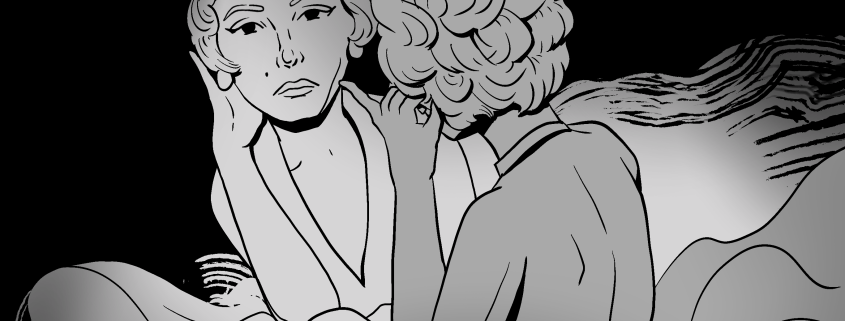What’s wrong with the sad girl aesthetic

The world loves a woman in pain. There is simply some inexplicable, inherent beauty in the melancholy experienced by women. Entwined with fragility, it almost carries an air of superiority: the sensitivity is profound; the frailty becoming; the vulnerability appealing — even alluring.
We see the wounded woman everywhere. In the recently released and deeply controversial film “Blonde” (2022), which quickly became Netflix’s No.1 movie after its debut, we once again witness Hollywood and the world’s obsession with female pain, even in death. Andrew Dominik, the writer-director of “Blonde,” treats Marilyn Monroe as nothing more than a victim, focusing solely on the traumas Monroe endured throughout her life. In the movie, if Monroe is not crying, she is naked — and there are many times she’s both.
As Manohla Dargis, the co-chief film critic of the New York Times puts it, “All that’s missing from this portrait is, well, everything else, including Monroe’s personality and inner life, her intelligence, her wit and savvy and tenacity; her interest in — and knowledge of — politics; the work that she put in as an actress and the true depth of her professional ambitions.”
“Blonde” should come as no surprise, however, as Hollywood’s necrophiliac obsession with women’s trauma is immemorial. Just three years ago, “Judy”(2019) was released, a biopic which has a plot bleakly similar to “Blonde’s.” The film follows beloved Hollywood star Judy Garland and her troubled life with mental illness and unhappy marriages.
But this preoccupation with the wounded woman — or as I’d like to call it, the “sad girl,” — is not just found in Hollywood, but everywhere. Are you a fan of literature? Look no further than Sylvia Plath or Virginia Woolf. Like to listen to pop music? My go-to-sad-girl is Lana Del Rey, but if you’re looking for more variety there are countless other familiar names in the official Spotify-curated playlist titled “sad girl starter pack,” which has almost a million likes.
Even my Instagram feed now is occasionally (frequently) taken over by post-cry teary-eyed but still beautiful selfies and mirror selfies of girls — a trend started by model Bella Hadid, whose crying selfies drew tremendous media attention. Even the “crying makeup” look has become TikTok’s latest trend, featuring girls with blushy cheeks, reddened noses, soft and puffy lips and most importantly, a glisten in her eyes that make her appear on the verge of crying.
Indeed, the “crying makeup” trend is the epitome of all that is wrong with the sad girl aesthetic, which has been around for almost 10 years now. With its sad, ethereal, and impossibly perfect post-cry look, quite literally, artificially manufactured by make-up, it is a misrepresentation of what female sadness actually looks like. I don’t know about you, but when I cry, my mascara gets everywhere, my eyes are puffy, lips swollen, skin blotchy — trust me, the last thing I want to do is to take a selfie and post it on Instagram.
Unlike the unrealistic and extremely aestheticized pretty-crying trope depicted by numerous downtrodden Hollywood heroines, women in real life do not cry while daintily wiping away a singular, glistening tear as it gently rolls down her rosy cheeks. Our tears are fierce and almost violent, fueled with rage, hurt and grief. It is an unapologetic outcry, not a suppressed, performative act of frailty. The real, implied message behind the sad girl aesthetic is this: suppress your real rage and ache, because even when you cry, your mascara has to stay on point.
The real logic behind the appeal of female suffering is to be sad is to be powerless. The pain of women turns them into birdies and kittens, delicate and vulnerable, into rosy sunsets and sordid red satin goddesses — its beauty fleeting and with a mark of decay. It pales women. It disempowers women. But we can’t look away — we can’t imagine new ways for them to hurt.
This was especially apparent during the Victorian Period of the 19th century. Women were placed into a domestic role as they were seen as too physically weak to work in the public sphere. While their pale thin bodies decay from tuberculosis, their fragility was perceived as beauty like a set of porcelain dolls. Years, decades and more than a century have gone by since the nihilistic 19th-century sentiment which mapped the appeal of the female suffering onto illness, combining sadness and beauty all at once. Yet, today, in 2022, we still aestheticize, romanticize, glamorize and fetishize female pain.
Stop romanticizing a woman’s pain. Turning pain into but another object of beauty is a fundamental disservice to all the power and force that was quietly contained in woman’s pain in the long history of women fighting against the patriarchy’s oppression. Protest doesn’t have to be external to the body — the pain itself can be seen as not an act of passivity, but an active tool for resistance and agency.
The logic behind the aestheticization of women’s pain implies that suffering is not only an aspect of the experience but also an element of the woman constitution; that pain is a requirement of femininity, and glue and prerequisite of a woman’s consciousness.
Our tears are not quiet, weak, stupid or shameful. Our tears could not be further away from beauty — they are forceful, sometimes even rageful, and they yield scars full of stories. Stare into the female pain, anguish, and suffering and you will be chilled.

